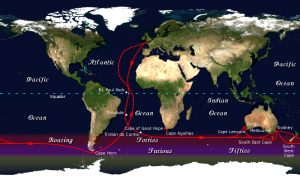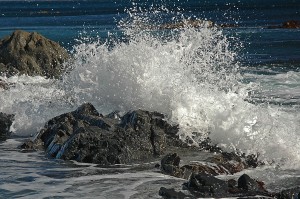They roar across the Indian Ocean and on into the South Pacific, battering any land mass that stands in their way. They were known during the Age of Sail, and helped to speed ships traveling from Europe as they navigated around the horn of Africa and onward to Australia. Even today, round-the-world yacht voyages and high-speed sailing competitions hope to catch a ride on the strong winds known as the Roaring 40’s.
The Roaring 40’s are strong, westerly winds found in the Southern Hemisphere, generally between the latitudes of 40 and 50 degrees. These fierce winds are caused by the combination of air being displaced from the Equator towards the South Pole combined with the force of the earth’s rotation.
As is true with most things in nature, the route and boundaries of the Roaring 40’s are not consistent, as they tend to shift north towards the equator in the southern winter and south towards the South Pole in the southern summer. However, New Zealand is generally sitting right in their path, where the winds can hit the islands on the west side.
The mountain ranges that run down the “spine” of the islands serve as a blockade, and create a rain shadow for much of the eastern coast of the country. For this reason, most of New Zealand’s vineyards are located in the rain shadows created by the Southern Alps on the South Island and various mountains and volcanoes on the North Island.
The Cook Strait, the band of water that separates the North and South Island of New Zealand, is the only opening for the winds between the two land masses and becomes something of a “wind tunnel” for the blasts. The Cook Strait, only 14 miles wide as its narrowest point, is understandably considered one of the most unpredictable and dangerous waterways in the world. The Cook Strait is named for James Cook, who, in 1770, became the first European to sail through it. The Maori name is Raukawa or Raukawa Moana.
While the Roaring 40’s are noted as being among the strongest winds in the world, they are, believe it or not, bested by even stronger winds that form closer to the South Pole, known as the “Furious Fifties” (50 to 60 degrees south), and the “Screaming Sixties” (below 60 degrees south).
For more information on “The Winds of Wine,” see our posts on The Mistral and The Zonda.
Click here to return to the SWE Website.

